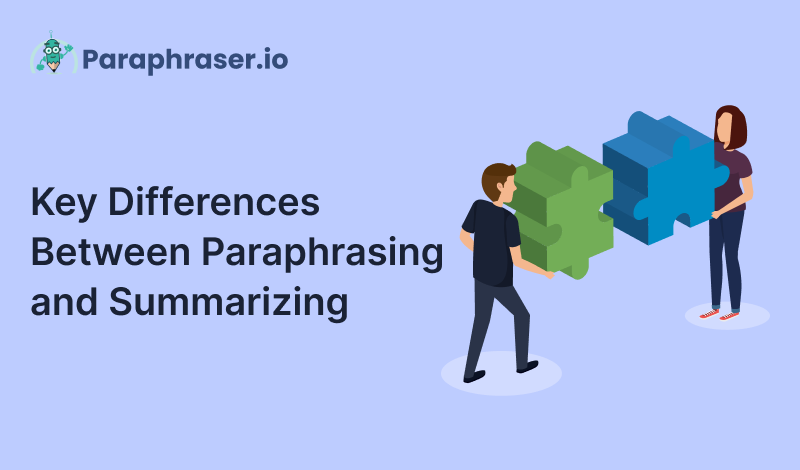
Key Differences Between Paraphrasing and Summarizing
Academic writing and everyday communication both require using ideas from various existing sources. But when people attempt this, they either become victims of plagiarism or fill their text with double quotes. In such situations, instead of overusing double quotes or committing plagiarism, there are two alternative solutions to this problem: paraphrasing and summarizing.
Both these techniques revolve around the concept of using original wording to explain the existing information by keeping the original meaning. That is exactly why people often get confused between them. If you are one of them, this blog post is here to help you. It covers what is the difference between summarizing and paraphrasing by discussing their definition, the right implementation approach, examples, and use cases.
Summarizing vs Paraphrasing: What’s the difference?
Before diving into the complexities here, it is essential to first clarify your understanding of summarizing and paraphrasing. So, the following definitions explain what’s the difference between paraphrasing and summarizing in the easiest-to-understand words:
What is Paraphrasing: Definition & Meaning?
Paraphrasing originates from the term ‘paraphrase,’ which means ‘explaining the meaning of something using different words to make it clearer.’ So, in light of this literal meaning, you can understand that paraphrasing is a rewording strategy in which you use your own wording and sentence structure to restate someone else’s information.
However, the main thing that the literal meaning doesn’t cover is that it is essential to keep the intent or meaning of the original text intact while paraphrasing. This means that paraphrased text will be considered wrong if it falls into one of the following criteria:
-
The wording and sentence structuring of the paraphrased text make it look unique, but it changes the entire intent or meaning.
-
The paraphrased text conveys the same meaning and intent, but the wording is too similar to the original version.
Correct and effective paraphrasing strategies include changing out words and phrases from the original sentence and replacing them with your own.
Here are some key points:
-
Use different synonyms, but keep the same meaning
-
Change some parts to rephrase the paragraph
-
Rearrange the structure of sentences
Here is an example to help you better understand the concept of paraphrasing:
Source Text: Climate change is causing severe weather patterns, which include more intense storms and droughts.
Wrong Paraphrase: The changing climate is resulting in extreme weather events, such as less rain and warmer temperatures. (Changes the meaning)
Incorrect Paraphrase: Climate change is leading to severe weather conditions, including stronger storms and drought. (Looks too similar)
Correct Paraphrase: The impact of climate change results in increasingly severe weather characterized by stronger storms and prolonged dry spells.
How would you know whether the changed content is enough to be original? Check through our free plagiarism checker to see if the text is too good to be original and can stand on its own.
What is Summarizing: Definition & Meaning?
Summarizing is the present participle form of the Latin term ‘summarium,’ which means ‘summary.’ And since ‘summary’ is a concise statement that covers the key points of something, the word ‘summarizing’ is the ‘process of distilling a lengthy text’s key ideas into a brief overview.’
It is also essential to maintain the original intent or meaning when summarizing something. This means that trimming down a piece of information to its essential bits and pieces must convey the same meaning as the original.
Here is an example that best elaborates on the concept of summarizing by covering the wrong and correct summarized forms of the exact source text:
Sample Passage: The rapid advancement of technology has significantly changed how people communicate. With the rise of social media, individuals can connect instantly across the globe, sharing ideas, experiences, and information in real time. This shift has transformed personal relationships and businesses' operations, enabling more efficient collaboration and outreach.
Incorrect Summary: Technology has changed communication. Social media helps people connect and share experiences. (It oversimplifies the source text and eliminates the crucial details)
Correct Summary: The swift development of technology, particularly social media, has revolutionized communication by allowing people to connect instantly worldwide. This transformation has not only enhanced personal relationships but has also improved business collaboration and outreach.
The Purpose and Scope of Paraphrasing and Summarizing
By now, you may have understood the core concepts & difference between paraphrasing and summarizing. So now let's move to their purpose, scope & the whys and whens for each strategy individually.
Reasons and Situations to Do Paraphrasing
-
As you know, paraphrasing revolves around using your own wording and understanding to convey an existing piece of information. Therefore, people most commonly use it to avoid plagiarism and content duplication. You might find our guide on how a paraphraser is effective against plagiarism helpful.
-
Paraphrasing indicates that it aims to clarify the information.
-
You can use the same topic to address the audience of different platforms (research paper and social media), but you can’t use the same tone. So, you can paraphrase your content whenever you want to tailor your text’s writing style and tone according to a specific audience.
The Role of Summarizing and Its Necessity
-
Summary shrinks down a lengthy piece of information to its essential details.
-
When you summarize something, you decrease its length with the help of clear and easy-to-understand words and sentence structures.
-
People often create summaries by identifying and expressing the key ideas. Writers often get help from text summarization writing whenever they want to polish their comprehension skills.
Comparison of Key Differences between Paraphrasing and Summarizing
Here is the review in the following table to understand the key differences between these strategies:
| Key Differences | Paraphrasing | Summarizing |
| Scope | Focuses on rewording while retaining complete detail. | Distills the information to its essential concepts. |
| Length | Same as the source. | Significantly shorter. |
| Use Case | Used when specifics are essential but require a different communication method. | Comes in handy when you need to provide a condensed version of the source material. |
| Personal Interpretation | Some degree of personal interpretation is allowed, but it should be according to the source context. | No room for personal analysis, interpretations, and opinions. |
How to Summarize and Paraphrase Any Text Piece?
You may have cleared up all your confusion about paraphrasing and summarizing by now. Now it’s time to share expert advice about implementing both techniques.
Tips and Suggestions for Paraphrasing
-
Before paraphrasing, make sure you fully understand the meaning and context. For instance, you can try to find out whether you can describe the source text without looking at it or not. If so, it means you’re ready to paraphrase it.
-
There are different ways to implement the art of paraphrasing. You can use the alternate vocabulary, change the sentence structure, modify the voice, reorder the information, etc. However, combining all these ways is an excellent practice for producing effectively paraphrased content.
-
If the paraphrased text looks too similar to the original one, you can use our AI-powered paraphraser. It has already been programmed with all the different ways to paraphrase text.
-
Finally, do not forget to add a reference to the original version of the information. Otherwise, even the correctly and effectively paraphrased information will become a victim of plagiarism.
Note: Go through our simple step-by-step guide on how to paraphrase a paragraph for a clear understanding of how a paraphrase tool works.
Tips and Suggestions for Summarizing
-
Reading the source text thoroughly before summarizing is essential. However, when summarizing, you should focus on identifying the crucial details according to the topic’s intent. Therefore, the best practice is to start highlighting every key point.
-
Once you’ve identified all the key points, you can start summarizing the information. You can break down complicated ideas into simpler language, change the arrangement, and group similar information together.
-
If you believe the summarized form looks similar to the original one or have trouble condensing its length, you can use our summarizing tool. It has already been trained to implement abstractive and extractive summarization techniques.
-
Lastly, make sure to cite the original text. If you forget to do so, your summarized form will be an example of an academic integrity breach.
Final Thoughts
Paraphrasing and summarizing are two essential skills that enable individuals to express ideas in their own words while retaining the core meaning of the original text. While both techniques uniquely present information, their focus and purpose differ. For instance, paraphrasing focuses on understanding and interpretation, while summarizing emphasizes brevity and clarity. So, these are the only key differences you must understand if you want to use them effectively and appropriately.
FAQs
Do paraphrasing and summarizing techniques fall under the umbrella of plagiarism?
No! Both paraphrasing and summarizing are effective techniques to eliminate plagiarism from the text. Therefore, they don’t fall under the umbrella of plagiarism as long as you cite the reference.
How do paraphrasing and summarizing compare in terms of understanding and effort?
Both summarizing and paraphrasing require a deep understanding of the source text. However, the difference between these two strategies is the actual effort. Paraphrasing focuses entirely on rewording, whereas summarizing emphasizes identifying and combining essential points.
Which statement best explains the difference between summarizing and paraphrasing?
Summarizing is the shorter version of information, covering only the essential point to explain the same thing without giving a detailed context. In contrast, paraphrasing means using your own words to restate something while retaining its full detail and meaning.

